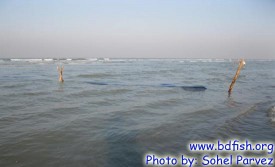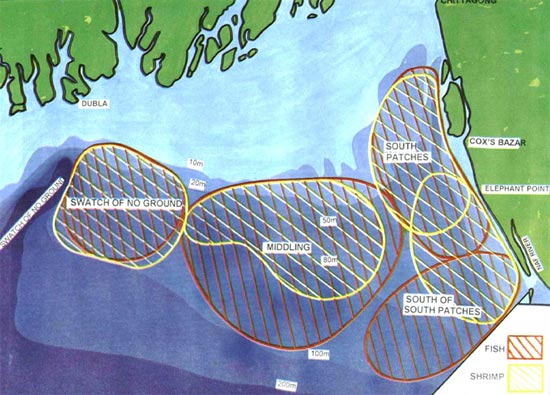
Bangladesh is endowed with vast marine and coastal waters having an area of about 1.5 times more than that of her total land mass. The environment is under the dynamic interface between terrestrial systems and marine systems dominated by wave actions and tidal currents from the Bay of Bengal. The land territory of Bangladesh is linked to the seabed and subsoil in the Bay by a singular process of erosion and deposition that has (a) lifted much of Bangladesh’s landmass out of the sea, and (b) shaped the highly unusual seabed throughout the Bay (ITLOS, 2010). The countries exclusive economic zone (EEZ) spans 164,000 sq. km and the shelf area covers roughly 66,440 sq. km (Hussain, and Hoq, 2010). Bangladesh sits in a broad and deep concavity at the northern limit of the Bay of Bengal, with Myanmar to its east and India to its west (ITLOS, 2010).
This marine and associated coastal zone is characterized by sprawling estuaries, dense mangrove forest, coral reef island and the world’s longest sea beach. There are many sedimentary islands in the estuary and along the coastline, and about seven sq. km of new land emerges from the sea every year (ITLOS, 2010). Fishing is the most significant economic activity on these islands besides serving as an important base of operations for the Bangladesh Navy and Coast Guard with a great potential of ecotourism.
The geographical position and climatic condition of Bangladesh have made her coastal areas one of the highly productive areas of the world (Islam, 2003). Recent surveys gave an estimate of demersal standing stock between 150,000 and 160,000 t. within the exploited 10-100 meter shelf area (Saetre 1981, Khan 1983, Lamboeuf 1987). Eight species of Tuna and Skipjack (Khan, 1983) and a number of potential species of Mackerels, Shark, Ray, Sardines, Anchovies, Shad and cephalopods, soles and flat-fish, lobster etc. are available in Bangladesh waters but detailed pelagic survey is yet to take place to provide a reliable estimate of their standing stock. The coastal and marine fisheries have been playing considerable roles not only in the social and economic development of the country but also in the regional ecological balance (Salam, et al., 2011).
Though the highest priority has always been accorded to the freshwater fisheries (as reflected in the number of projects implemented), it is impossible to acquire sustainable development and fulfill the protein requirement of the teeming millions from this subsector alone despite the marine fisheries has the lion’s share of foreign exchange earnings. But most of these resources have been over-fished and are declining at an alarming rate (Khan, et al., 2003). If similar level of management and development attention is paid to the marine sector through a holistic approach, it will pave the way to a greater achievement towards sustaining the fish stocks for livelihoods and food security for future generations.
The Bangladesh coast supports about 587,400 ha of natural mangroves (Mahmood, 1986) providing the habitat of several species, particularly the younger stages of shellfish and finfish (Mahmood, et al., 1994). A total of 50 species of crabs (Quader, 1994), 30 species of mollusks (Salam, et al., 2011) have so far been recorded from the coastal and marine habitats of the Bay of Bengal. Fourteen species of seaweeds were recorded from the St. Martin’s Island (Rahman, 1999). Four species of Acropora and 10 other coral reef genera have been reported from off shore islands, seafronts of newly formed islands and some low lying coastal areas are often carpeted with sea grass (Hussain, and Hoq, 2010).

Mariculture can develop and uplift the livelihood security of the coastal communities and play a significant role in the national economy by providing raw materials for various industries along with export to international markets. Besides, it will check the overexploitation from the natural sources ensuring the future prospects and sustainability of the resource utilization.
The minimal elevations of the coastal area from the mean sea level made its extremely susceptible to flooding produced by monsoons, tidal streams, cyclones, and, increasingly, by sea-level rise caused by climate change. But it is quite ridiculous to think how a country like Bangladesh with a booming population of about 160 million is not coming forward to utilize and manage her marine and coastal resources.
We need to carry out various seismic, gravity and magnetic surveys, fisheries stock assessments and exploration and extraction of mineral and petroleum deposits. Very recently, The International Tribunal for the Law of the Sea (ITLOS) gave its judgment on the dispute with Myanmar on the delimitation of our maritime boundary following the concave nature of our coast (ITLOS, 2010b). But she is still struggling to establish maritime boundary with India that has been pending since 1974, as the waters are not delimited, Bangladesh cannot explore and exploit certain areas (Rashid, 2009). National security system in maritime boundary needs to be strengthened to protect illegal fishing and mineral exploration by the neighboring countries. But the country has a serious dearth if skilled manpower in the marine sector to plan and conduct studies on the development and proper utilization of the resources. Whereas development of human resources on various aspects of ocean and fisheries disciplines is in the topmost priority overseas.
Diverse and abundant marine and coastal life forms and mineral and petroleum resources as well as the potential use of tidal and wave energy is becoming increasingly important to ensure the socio-economic development and fulfilling the strategic objectives of the country. So, the country has a long way to go for proper utilization and management of her marine and coastal resources for national flourishing and sovereignty with an integrated and holistic approach. The government should come forward in this regard and the Bangladesh Navy and other research and academic institutes should extend co-operation in studying the physical and dynamic processes of the sea in various fields of oceanography, to facilitate exploration and exploitation of sea resources while the regional understanding and relationship couldn’t be over locked.
Reference:
- Hussain, M.G. and Hoq, M.E. (eds.). 2010. Sustainable Management of Fisheries Resources of the Bay of Bengal- Compilation of national and regional workshop reports. Support to Sustainable Management of the BOBLME Project, Bangladesh Fisheries Research Institute. SBOBLMEP Pub./Rep. 2. 122 p.
Islam, M.S. 2003. Perspectives of the coastal and marine fisheries of the Bay of Bengal, Bangladesh. Ocean and Coastal Management. - ITLOS (International Tribunal for the Law of the Sea). 2010. Dispute Concerning Delimitation Of The Maritime Boundary Between Bangladesh And Myanmar In The Bay Of Bengal, Memorial Of Bangladesh, Volume I.
- ITLOS (International Tribunal for the Law of the Sea). 2010b. Dispute Concerning Delimitation Of The Maritime Boundary Between Bangladesh And Myanmar In The Bay Of Bengal, Joint Declaration Of Judges Ad Hoc Mensah And Oxman.
- Khan, M.G. 1983. Results of the 13th Cruise (July, 83) with the R.V. Anusandhani of the demersal fish and shrimp ground of the Bay of Bengal. Bangladesh Marine Fisheries Research Management and Development Project, Chittagong.
- Khan, M.A.A., Sada, N.U., and Chowdhury, Z.A. 2003. Status of the demersal fishery resources of Bangladesh, p. 63 – 82 In G. Silvestre, L. Garces, I. Stobutzki, M. Ahmed, R.A. Valmonte- Santos, C. Luna, L. Lachica-Aliño, P. Munro, V. Christensen and D. Pauly (eds.) Assessment, Management and Future Directions of Coastal Fisheries in Asian Countries. WorldFish Center Conference Proceedings 67, 1 120 p.
- Mahmood, N. 1986. Effect of shrimp farming and other impacts on mangroves of Bangladesh. Paper presented at the 3rd session of the IPFC working party of experts on inland Fisheries, Bangkok, Thailand.
- Rahman, A., Islam, M.A., Roy, I., Azad, L., and Islam, K.S. 1995. Shrimp Culture and Environment in The Coastal Region, Working paper New Series No.8, Bangladesh Institute of Development Studies, Dhaka, Bangladesh.
- Quader, M.A. 1994. Strategies for proper management and utilization of marine resource of the country. A paper presented at the workshop on sustainable development of marine fisheries resources in Bangladesh. FRI, Cox’s Bazar.
- Rashid, H. 2009. Bangladesh-India Maritime Boundary, The Institute of Peace and Conflict Studies (IPCS) New Delhi, India.
- Salam , M.A., Hossain , M.S., Tareque, A.M.H., 2011. Studies on the present status and future potential of molluscs, dry fish and crab in Bangladesh coast: A GIS methodological perspective. Value Chain and Market Assessment of Coastal and Marine Aquatic Products of Bangladesh, Bangladesh Fisheries Research Forum (BFRF).
Visited 6,675 times, 2 visits today | Have any fisheries relevant question?
